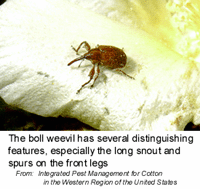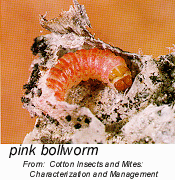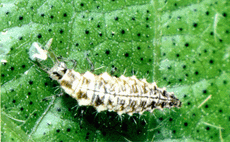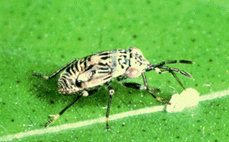|
|
|
|
|
|
|
|
Cotton Pests:
Insect populations thrive on cotton crops. Two of the major cotton pests are the boll weevil and the pink bollworm. |
|
| The weevil is a pest which primarily attacks flowers and bolls. A boll weevil can destroy the cotton lint with its feces and consume the cotton seeds. There is currently an eradication program for the boll weevil. |

|
| The pink bollworm is another major pest which also infests the bolls and flowers. The adults appear as gray and brown moths, and usually lay their eggs under the calyx of developing bolls. |

|
|
Cotton pests are currently the subjects of a broad array of research. Control of the cotton pests, such as mites and budworms, is sought through different methods: chemical control through the use of pesticides, biological control through the use of the natural predators of cotton pests, and cultural control through the modification of farming practices.
|
|
|
Some of the insects used in the biological control method are the lacewing and the geocoris.
|
|
 Lacewing larvae are important natural predators of cotton plant pests. The immature lacewing above uses its mandibles to pierce and feed on its prey.
Lacewing larvae are important natural predators of cotton plant pests. The immature lacewing above uses its mandibles to pierce and feed on its prey.From: Integrated Pest Management for Cotton in the Western Region of the United States |
 The geocoris is another important predator of cotton pests. The immature geocoris above is feeding on a bollworm egg.
The geocoris is another important predator of cotton pests. The immature geocoris above is feeding on a bollworm egg.From: Integrated Pest Management for Cotton in the Western Region of the United States, Second Edition |
|
| |
|
Introduction | Flowers&Fruit | Roots | Stems | Leaves Section of Plant Biology Division of Biological Sciences UNIVERSITY OF CALIFORNIA, DAVIS |